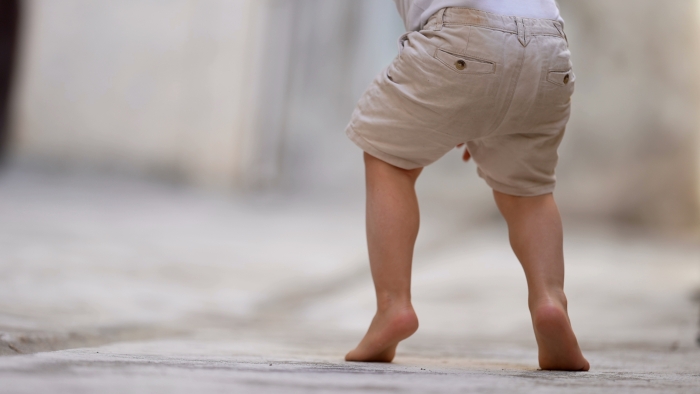Tactile Defensiveness in Children: Strategies to Help

This post may contain affiliate links; please see our terms of use for details.
- Tactile defensiveness is a sign of sensory processing difficulty that causes a child to be hypersensitive to normal touch sensations.
- Children with tactile defensiveness may overreact to light touch leading to avoidance, defiant, or aggressive behaviors in order to limit sensory experiences that they find unpleasant.
- A pediatric occupational therapist can help your child decrease their tactile sensitivity.
At the end of a long day when your kids have been using you as their personal play gym, you may feel so touched-out that even normally non-threatening tactile sensations like hugs can make you irritable. You might even feel tempted to yell “Leave me alone!” at your children because you are so overstimulated.
For children with tactile defensiveness, this feeling is the norm. Their threshold for irritability from tactile stimulation is low. Children with tactile defensiveness can quickly become overstimulated in everyday situations, leading to emotional outbursts and avoidance of sensory experiences that they find overwhelming.
Tactile Defensiveness: What Is It?
Tactile defensiveness is a type of sensory defensiveness that causes hypersensitivity to certain tactile stimuli, typically light touch and off-putting textures. Touch sensitivity is a sign of poor sensory integration, which means that the brain has difficulty processing sensations appropriately.
What may be acceptable touch or texture for many children will feel overwhelming for a child with tactile sensitivities.
An unexpected touch, the feeling of a stray hair moving across the skin, or various textures may trigger emotional outbursts or irritability in children with tactile hypersensitivity. The child’s behavior may seem out of proportion with the tactile input they received, and they may lash out to get away from the uncomfortable sensation.
Children are just developing the ability to regulate their emotional responses, so these outbursts can resemble a meltdown or sometimes even be violent. Normal tactile input can trigger an almost “fight or flight” response, leading to the child with sensory sensitivity either running from the input or fighting to get it away from themselves.

How Does Tactile Defensiveness Affect Development?
Though tactile defensiveness is a common feature of sensory processing disorders, it is not itself a disorder. Tactile defensiveness may be present with or without neurodivergent diagnoses such as autism.
Tactile sensitivity may or may not affect child development. Children with these sensory sensitivities may develop skills at an equal pace to their peers and have no cognitive deficits. Other children with tactile sensitivity may have developmental delays, which is more likely if they also have a diagnosis of autism spectrum disorder (ASD) or a genetic condition.
Children without a medical diagnosis may also have developmental delays if their tactile sensitivity leads to poor interaction with their environment or a significant avoidance of social and play situations. Those children may not learn age-appropriate social and gross motor skills due to limited exposure to new experiences compared with their peers.
Decreasing tactile sensitivity can have a huge effect on child development since it gives children the tools and confidence to experience new things and interact more with their family, friends, and surroundings. This may decrease the risk of developmental delay.
What Causes Tactile Defensiveness?
The human brain is designed to detect threats in the environment. The touch system, or sensory system, alerts the brain when damage is caused to the body or when potential threats are present. The sensory system also helps the brain tell the difference between different textures and how much or little input is present.
Different nerve endings, or sensory receptors, in the body detect changes in temperature, pressure, vibration, and stretch. Nociceptors are nerve endings specifically designed to detect pain. These sensations are all essential to keep the body safe and to help direct movement patterns. The neurological system is formed during prenatal development and becomes more refined as children interact with their environment.
Light touch and normal temperatures should not cause pain. However, in people with poor sensory integration and who cannot distinguish between harmful and non-harmful sensations, even the feeling of denim jeans moving on their legs or a tap on the shoulder can trigger a pain response. Pain or discomfort is what then triggers the unexpected fight-or-flight response.
It’s unclear what causes tactile defensiveness. Some theories suggest that the brain is not distinguishing between sensations well. Others believe that light touch sensations are “louder” than other sensations in sensitive individuals, crowding other input out and causing hyperfocus on light touch and increased threat perception.
Signs of Tactile Defensiveness in Children
If you are concerned about your child’s response to sensory input, please contact their pediatrician. They may refer your child to occupational therapy for an evaluation. Some signs to look out for may be:
- Your child becomes upset during hygiene activities like nail clipping, teeth brushing, hair brushing, or bath time.
- They display an aversion to certain fabrics, particularly fabrics that are scratchy or too tight or loose. May also find tags and seams irritating.
- Dislikes hugs and kisses.
- Avoids large crowds and stands far apart from others in social situations.
- Walks on tiptoes, especially when barefoot on surfaces that feel strange, like grass or rough carpeting.
- Refuses to eat certain food textures (e.g., squishy, crunchy, or slimy).
- Avoids messy play and toys like finger paint and sand.
Typically, an occupational therapist will observe your child and have parents and/or other caregivers fill out questionnaires to understand how a child behaves at home. This can include the Sensory Profile which addresses your child’s response to a variety of sensations, including tactile, auditory, and visual. Here is a sample sensory profile to give you an idea of what an OT may look at.
Can Tactile Defensiveness Be Cured?
Tactile defensiveness is not a disease or diagnosis, but rather a sign that the brain processes information differently. A child may not be fully “cured” from sensory processing dysfunction, though they can learn to regulate their emotional responses and become more accustomed to light touches and a variety of sensory input with the help of a trained occupational therapist (OT).
Over time, occupational therapy can decrease touch sensitivity and improve a child’s daily functioning through the use of strategic tactile activities and deep pressure. Addressing sensory processing difficulties early on may also help your child avoid delays in typically developing speech, social, and gross and fine motor skills.

6 Strategies to Help a Child With Tactile Defensiveness
Handling tactile defensiveness may be difficult for parents who have no sensory processing issues of their own. Sensory input that seems harmless to parents may set off a child with sensory sensitivities, much to the surprise of the parent. Learning your child’s triggers can help you manage their environment and responses until sensory strategies can be implemented.
Some kinds of sensory input have a calming effect on children with tactile defensiveness. This includes deep pressure sensations as opposed to light touch. Graded exposure to the tactile input that these children find painful or off-putting can also help improve sensory integration over time.
Some strategies are best guided by an OT during regular therapy sessions. These professionals can help determine if the right amount of input is provided for sensory modulation or if the input is too much, too soon. Additionally, OTs are great at educating parents on the appropriate use of sensory strategies.
1. Emphasize Communication
Support your child’s feelings when they experience pain or discomfort with tactile input. What they perceive is valid! However, maintain appropriate boundaries—hitting, biting, and kicking are never acceptable ways to express emotion.
Prepare teachers and other caregivers by telling them in advance what things may trigger an emotional outburst from your child. Explain to the caregivers that your child is not attempting to manipulate and is not overreacting. The child is truly experiencing something uncomfortable.
2. Use Weighted Products
- Home, Travel, and Classroom Use – Our versatile sensory vest can be worn wherever and whenever your child needs feel more in control, including on long car rides, in class with friends or teachers, or out running errands
- Soft, Breathable, and Supportive – Designed to wrap comfortably over the shoulders and around the midsection our vest for kids lets them move, play, and experience life with natural mobility while staying cool and relaxed on the go
- Soft, Breathable, and Supportive – Designed to wrap comfortably over the shoulders and around the midsection our vest for kids lets them move, play, and experience life with natural mobility while staying cool and relaxed on the go
The constant deep input of a weighted vest or weighted blanket can have a significant calming effect on children with sensory processing issues. It is possible that the continuous input from these products distracts the brain enough to reduce the focus on light touch that tactile defensive children find threatening.
Additionally, children who wear weighted vests during the day may also see improvements in proprioception, coordination, and stability, which supports appropriate gross and fine motor development.
- 9 OUT OF 10 CUSTOMERS REPORTED INCREASED COMFORT FOR THEIR CHILDREN WITH THE HAZLI WEIGHTED BLANKET – The Hazli heavy blanket provides gentle pressure that promotes a sense of well-being for your child. Unlike other kids weighted blankets, it is filled with natural materials, creating a cozy environment for children. Plus, it’s washable for added convenience.
- INSTANT FAVORITE BLANKET WITH UNIQUE SUPER SOFT SNUGGLE FEEL – The Hazli kids weighted blanket, 5 pounds, is encased in a luxurious soft minky cover, offering a comforting touch that children adore. It quickly becomes a household favorite and the preferred blanket for cozy moments.
- SOOTHING SENSATION FOR KIDS – Featuring a nine-layer design with 10’’ pockets for optimal weight distribution, the Hazli kids blanket offers unparalleled comfort and a sense of security for children during relaxation or daily activities.
- 2 IN 1 KIDS WEIGHTED BLANKET – The Hazli kids weighted blanket washable feature includes a pre-attached, easy-to-wash cover for added convenience. Its high-quality construction ensures lasting softness, making it perfect for snuggling up during any season.
3. Try Deep Pressure
This is a great tool to have in your belt! Deep pressure can be used to bring a child down from a heightened state of emotion. A steady hug or firm squeezes with open hands around the rib cage can calm a child who is acting defensive. Joint compressions (as taught by an OT) can also help the child process sensations.
For a fun way to provide deep pressure, give your child squishes with a pillow or favorite stuffed animal. Make sure to stop when your child indicates they are done with the activity. Deep pressure should be a safe, calming strategy to counteract overstimulation.
4. Modify the Environment
Choose clothes that are made of preferred fabrics and stretchy materials that are easy to put on and take off. Help your child choose healthy foods that have their preferred textures (e.g., if they like crunchy orange foods, try some carrots!). Also, allow them breaks from situations that feel too crowded or overstimulating.
5. Develop Heavy Work
Children with sensory processing difficulties benefit from doing exercises that give their bodies lots of strong input. This can include having them carry heavy objects, crash onto mats or cushions, and do animal walks or wheelbarrow exercises.
These exercises help provide proprioceptive input, or an awareness of where their body is in space. Since the input from heavy work is so strong, this helps their brain process sensory information better, while also improving stability, coordination, and body awareness.
6. Wilbarger Brushing Protocol
- THERAPRESSURE SENSORY BRUSH – this Therapressure brush is designed to deliver a deep pressure massage to help improve sensory defensiveness. Includes 6 brushes
- AN ESSENTIAL TOOL – use as part of the Wilbarger Brushing Protocol (Brushing Therapy) to help improve attention span, focus and ability to transition between activities
- HOW TO USE – best when used with the guidance of a trained occupational therapist. Run the soft, dense bristles over the skin with moderate pressure for a calming sensory experience
- PORTABLE – these sensory brushes measure 3.5 x 3.2 x 2.2 inches. The portable size makes it ideal for taking it with you wherever you go
This strategy uses a special brush to provide deep pressure down a child’s arms and legs in order to decrease sensory defensiveness and to improve emotional regulation, anxiety, and focus. The protocol takes only a few minutes to perform every couple of hours.
After brushing, typically light joint compressions are applied at arm and leg joints (e.g., elbows and hips).
Due to the complexity of this protocol, this strategy is done under the direction of an OT. Your child’s OT will reevaluate the effectiveness of the protocol and progress it as appropriate. Therapeutic brushing may not be a good fit for every child.
Sensory defensiveness is a complex and challenging issue that affects many children, but with early recognition and intervention, supporting your child with sensory defensiveness is possible! Work together with your child’s healthcare providers and educators to develop a realistic plan and use positive reinforcement to encourage positive behaviors.

The information WonderBaby provides is not intended to be, and does not constitute, medical or other health advice or diagnosis and should not be used as such. Always consult with a qualified medical professional about your specific circumstances.
Related Posts

Eye Conditions and Syndromes, Visual Impairment
Neuralink Announces Plans to Restore Sight to the Blind with Brain Chip
Elon Musk’s company Neuralink has announced plans to begin human trials of its new “Blindsight” brain chip by the end of 2025.

Special Needs
5 Spring Cleaning Tips for Families of Children with Disabilities
Spring cleaning is an opportunity to create a more accessible, organized, and supportive space for your child with disabilities. Declutter, deep clean, and refresh!

Visual Impairment
The Gift of Understanding: How a Young Child Helps His Blind Father Navigate Life
When a parent is blind, it’s natural for people to wonder how their sighted child will adapt. Will they struggle to understand their parent’s needs? Will they feel burdened by...


